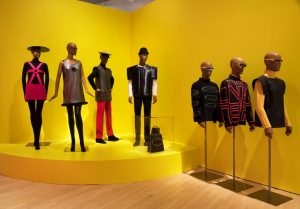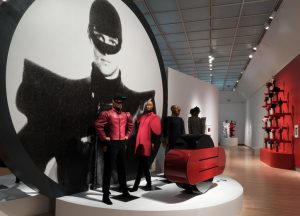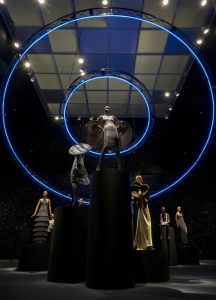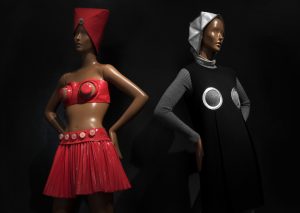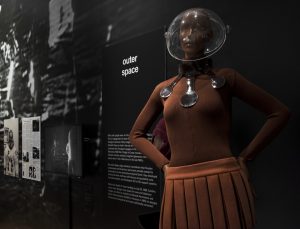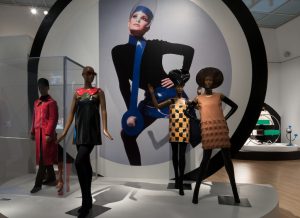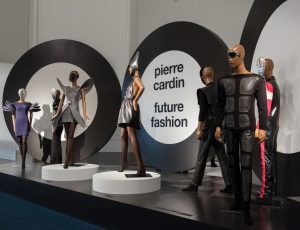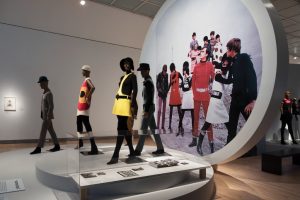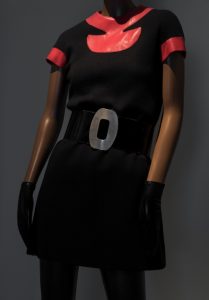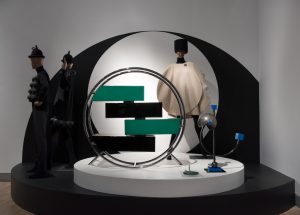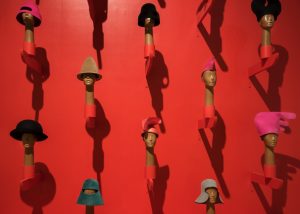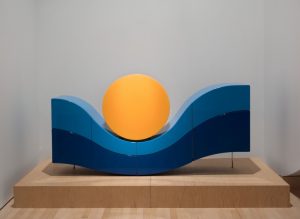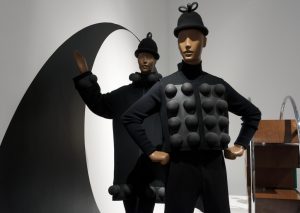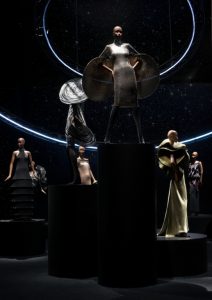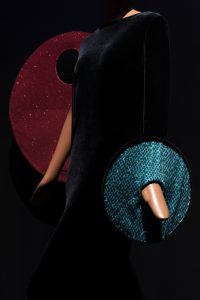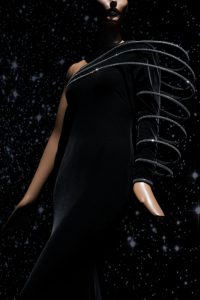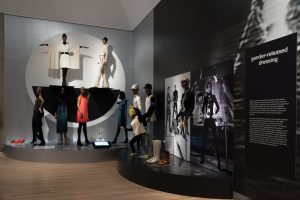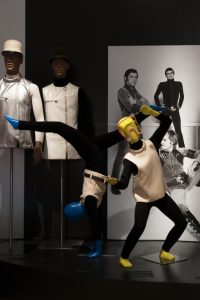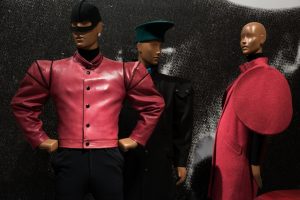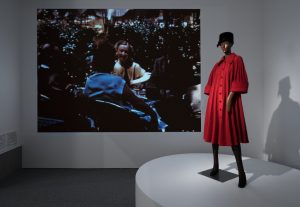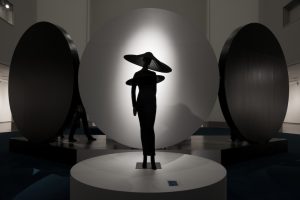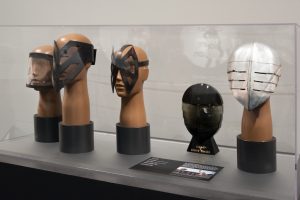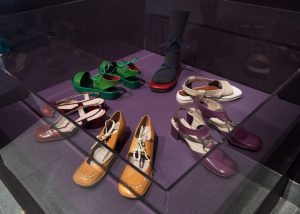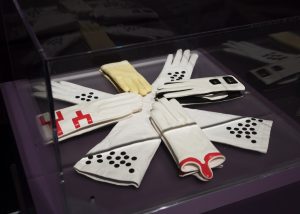Fashion and art are both time-honored barometers for the pulse of society, and the heartbeat of culture. As the two represent nuances of the moment and measure the temperature of the times, it’s important to recognize the value of looking back as we endeavor to move forward. At the Brooklyn Museum, Matthew Yokobosky, Senior Curator of Fashion and Material Culture, does just that in the timely and striking exhibition, “Pierre Cardin: Future Fashion.” The presentation of the master couturier’s work launches us into the future while simultaneously looking backward at a tumultuous and groundbreaking time. As we celebrate the 50th anniversary of the many events that helped shape our world, from Woodstock to the Apollo 11 moon landing, Cardin’s work stands today as a bookmark of the past, and a jet propulsion into the unknown.
The exhibition, featuring more than 170 pieces from the designer’s atelier and archive, opened July 2019 and will run through January 5, 2020. The retrospective documents a lifetime of innovation and design, from space-age fashion and unisex creations to illuminated apparel, couture furniture and advances in global licensing.
The Italian-born French designer’s work spanned seven decades, tantalizing the fashion world with his avant-garde future-forward visions and out-of-this-world silhouettes. A true chronicler of the times and prognosticator of the future, he endeavored to answer the question: What will women wear on the moon? At the height of the “space-race,” he had a launch of his own with the introduction of Cosmocorps, an apparel collection featuring futuristic one-piece jumpsuits, miniskirts, parabolic shoulders, meandering pleats, orbiting shapes and geometric accessories. During a visit in 1964 to the NASA Space Center Houston, he became the only civilian (ever) to try on a spacesuit. Donning the Apollo 11 space garb worn by Buzz Aldrin, he was further inspired to take fashion to another galaxy.
Born one of 10 children in Venice in 1922, Pietro Cardin moved with his family to Saint-Étienne, France, at the age of two, escaping the National Fascist Party government in Italy. His first job was as a tailor’s apprentice where he learned how to craft handmade button holes. At 20 he wanted to go to Paris to become a couturier. He had a bicycle and was going to pedal his way to Paris. He got as far as Vichy, the seat of France’s puppet government, when WWII broke out. There he worked for a tailor honing his craft and for the Red Cross, where he learned accounting, a skill that stead him well as he built his fashion empire.
In 1945, when the war ended, he finally made his way to Paris where he served as an apprentice to the couturier Jeanne Paquin. Soon after, he had a brief stint in the studio of Elsa Schiaparelli until he met a young man by the name of Christian Dior. Working in the Dior studio, he helped usher in the “New Look” collection. He remained at Dior until 1950 when he bought a costume-making business where he began to make ball costumes. In 1952, he made his first couturier sketch.
The legendary designer’s work continued into the 1950s when he became known for his back “loop eye of the needle” design. Then in 1957, he designed a red wool suit for Jackie Kennedy. The future First Lady first wore it to a Congressional hearing, and then on a TV tour of her Georgetown townhouse. It was worn again at the suggestion of Oleg Cassini, her fashion advisor, on a state visit to Canada – mainly because the Royal Mounties wore red. The First Lady obliged.
Advertisement
In 1958, Cardin was the first couturier to be displayed and sold in a department store. Amid much controversy, Cardin democratized fashion with the launch of a prêt-à-porter (ready-to-wear) collection in Printemps, a popular Parisian department store. To his critics, he said, “Why should I let other people copy my designs when I could do it myself?” The couture was sold as a loss leader, while the profit center was the ready-to-wear line. Yokobosky said, “When you follow your own creative path, you can make people aware of ideas in business and fashion that they perhaps hadn't considered. And so a couturier making prêt-à-porter in 1959 seemed unthinkable; today it’s standard practice and spreads good design to a greater public.”
Cardin was also one of a handful of couturiers to design apparel for men. In 1959, he created his first men’s collection, leading a revolution that simplified men’s clothing. In the cylinder collection he removed the jacket collars. This was attributed to The Beatles, but it was inspired by Cardin.
Then, in the ’60s, he began to license the Pierre Cardin name. He was keen on quality control; his name was synonymous with excellence. All garments had to have his name or his initials, PC, on them. He then stopped advertising. His product promoted itself.
In the early 1960s, he was invited to Japan to teach 3-D cutting. It was there that he met Japanese designer Kenzo Takada, who was one of his students. He also met the model Hiroko Matsumoto, who famously modeled his creations.
As his designs rocketed deeper into the cosmos, skirts became shorter and men’s jackets got longer. Cardin created a dialogue, or a polarity, between the short and the long. Inspired by space travel, and analogously motion, his clothes took on a suggestion of kinetics and movement. Pants were designed with little wheels at the ankle. His famous car wash dress, constructed of wool crepe and jersey, featured a fringed hem and kinetic back. Yokobosky added, “Creatively, when you have honed your crafts you can realize your dreams, and so Cardin was able to invent new silhouettes and ways of dressing, that helped move the fashion conversation forward.”
In 1968, Cardin’s creativity took another turn as he peered deeper into the future with the design of “Light Up Clothes.” LEDs were embroidered into the clothes for a striking futuristic look. So analogous was he to space-age fashion, that an episode of the “Jetsons” animated TV show featured “Pierre Martian,” a clear nod to the intergalactic visions of the experimental designer.
Advertisement
The legendary Battle of Versailles Fashion Show was held in 1973 to raise money for the restoration of the grand Palace of Versailles. Five French designers, including Pierre Cardin, Yves Saint Laurent, Emanuel Ungaro, Christian Dior, and Hubert de Givenchy, competed with five American designers – Oscar de la Renta, Halston, Bill Blass, Stephen Burrows, and Anne Klein. True to form, Cardin’s model, wearing a stunning Cosmocorps outfit, popped out of a rocket ship.
As critical acclaim grew, he was invited to China in the late 1970s as an adviser to the textile industry. This was a great source of inspiration as soon after he created the pagoda shoulders. Then in 1984, he staged a fashion show on the Great Wall where he showed a bride in a red dress, red being an important color in Chinese culture. Some controversy arose as he showed two brides, one in red and one in white.
For Cardin, inspiration was everywhere, especially if it was related to technology. After a visit to the IBM computer lab, he designed the “computer coat” with origami-like pleats, a lamp, a watch, and even an airplane, using the same computer-inspired pattern on all.
Curated in a narrative fashion, Yokobosky cleverly arranged the exhibition thematically with less emphasis on chronology. The welcoming gesture is a dynamic grouping of seven mannequins, all wearing the couturier’s most iconic space-aged designs. Visitors are then led from point to point and gallery to gallery by strategically positioned focal points. TV monitors are thoughtfully placed throughout to help tell the Cardin story, and color is subtly incorporated emphasizing particular collections and points of view.
The pièce de résistance is the exhibition’s final gallery where the viewer is transported into outer space. Any great work of art takes the viewer to another place, perhaps another time, or possibly another state of mind. Here the viewer is transported in spirit to celestial spaces of imagination. In a darkened room, 1400 multicolored LEDs are individually programmed to replicate the vast reaches of the universe while a 28-foot illuminated cosmic ring, reminiscent of that which encircles Saturn, mellifluously frames the room.
Yokobosky recalls one of his many conversations with the designer when he said that his evening wear creations were inspired by early memories of stargazing. “As a child he looked up at the sky and imagined all the stars were women in evening gowns. He wanted to make women look like galaxies.” This revelation was also an inspiration to the curator as he designed the exhibition.
Advertisement
Still working at 97 years of age, Cardin is in his atelier daily as he continues to produce inspired designs. Yokobosky hopes visitors come away with the understanding that, “You don't have to retire; staying active can mean having a long, influential career and a long, rewarding life!”
Eric Feigenbaum is a recognized leader in the visual merchandising and store design industries with both domestic and international design experience. He served as corporate director of visual merchandising for Stern’s Department Store, a division of Federated Department Stores, from 1986 to 1995. After Stern’s, he assumed the position of director of visual merchandising for WalkerGroup/CNI, an architectural design firm in New York City. Feigenbaum was also an adjunct professor of Store Design at the Fashion Institute of Technology and formerly served as the chair of the Visual Merchandising Department at LIM College (New York) from 2000 to 2015. In addition to being the Editorial Advisor/New York Editor of VMSD magazine, Eric is also a founding member of PAVE (A Partnership for Planning and Visual Education). Currently, he is also president and director of creative services for his own retail design company, Embrace Design.
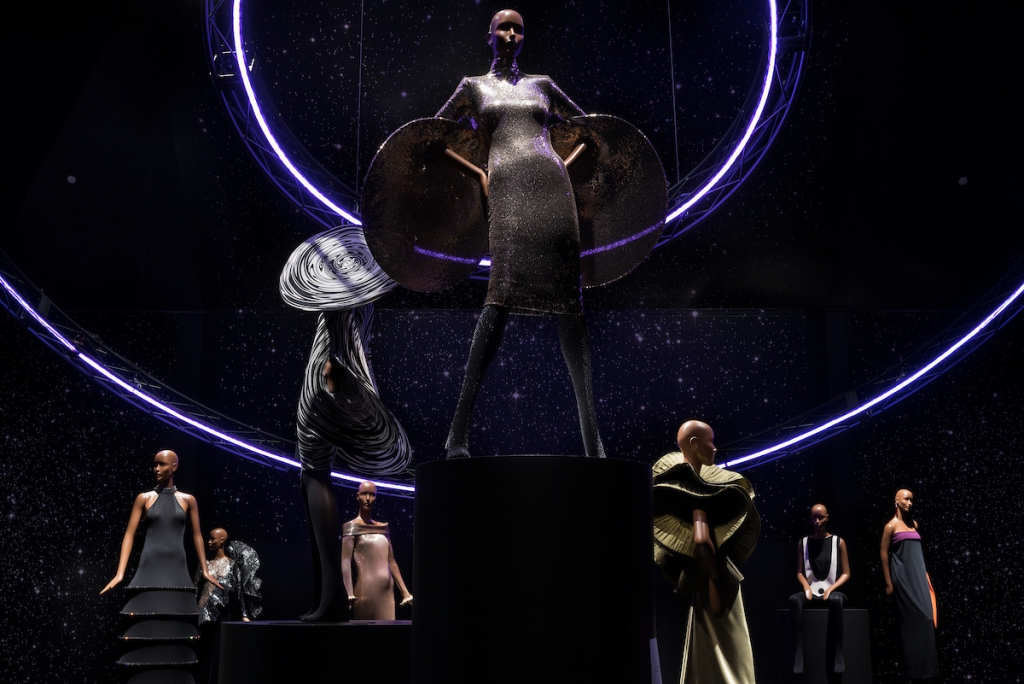

 Photo Gallery3 days ago
Photo Gallery3 days ago
 Headlines2 weeks ago
Headlines2 weeks ago
 Sector Spotlight2 weeks ago
Sector Spotlight2 weeks ago
 Headlines1 week ago
Headlines1 week ago
 Headlines5 days ago
Headlines5 days ago
 Headlines2 weeks ago
Headlines2 weeks ago
 Designer Dozen1 week ago
Designer Dozen1 week ago
 Headlines3 days ago
Headlines3 days ago


